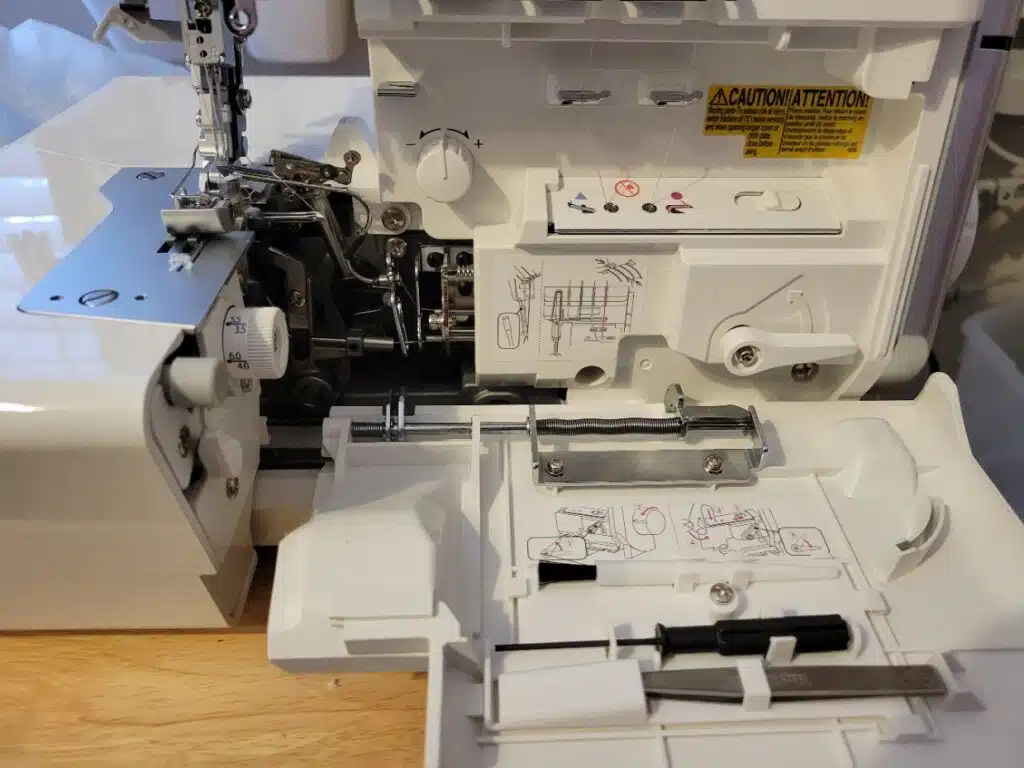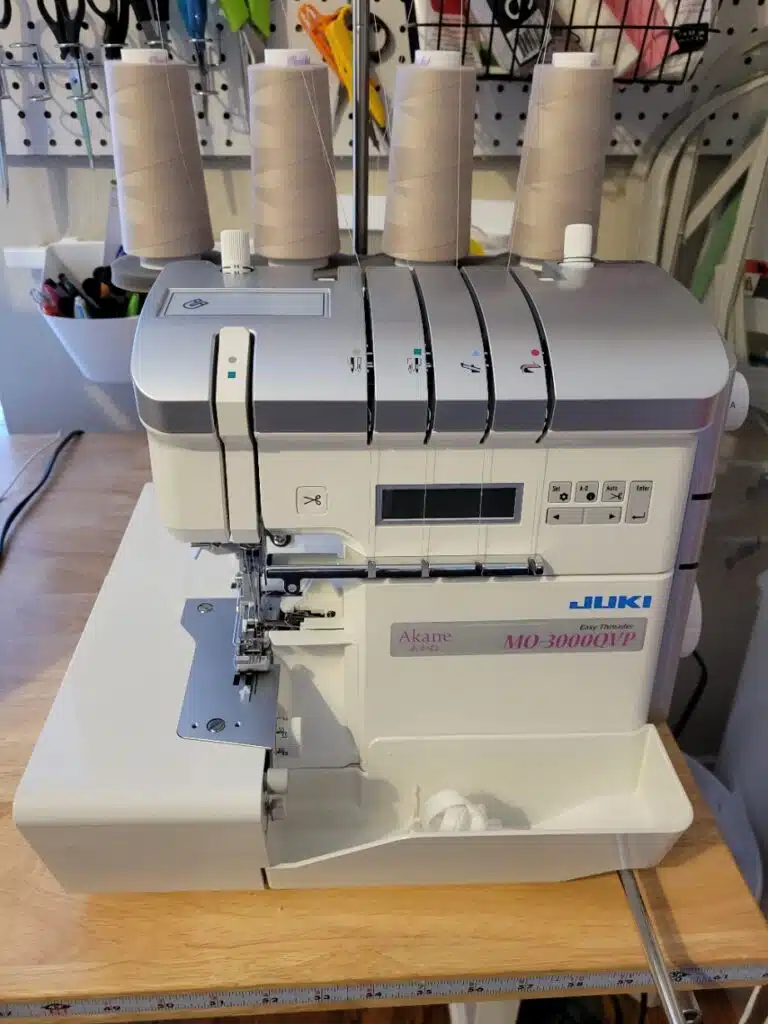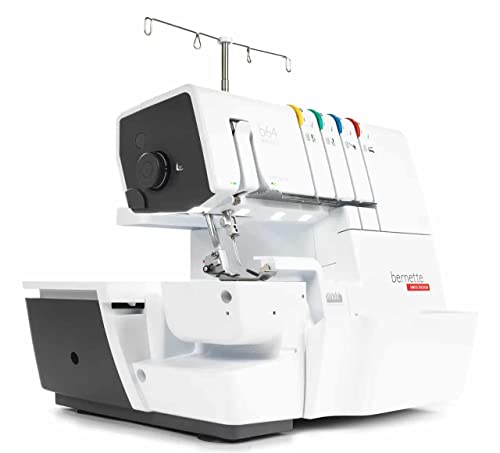The Best Self-Threading Sergers (Air-Threading Options)
This post may contain affiliate links, which means I’ll receive a commission if you purchase through my links, at no extra cost to you. I sometimes receive free products for review. Please read disclosure for more information.
I loved my trusty Brother 1034D and 1034DX sergers for many years. And yes, I owned two sergers–one threaded with white thread and one with black.
Not only was changing threads a pain, but I started having more difficulty with hand and finger dexterity, and trying to change threads became flat-out demoralizing.
Unfortunately, I have a connective tissue disease that affects my joints, and I’m learning to accept the slight (but unfortunately, noticeable) degradation of fine motor skills as my new normal.
Thankfully, after watching me frustratedly fiddle with my manual serger one night before blazing out in a fit of anger, my sweet husband encouraged me to sell my old sergers and purchase a self-threading serger.
After much research and hands-on time, I finally decided on the new Juki MO-3000QVP, and I love it.
However, as I compared all available options, I compiled this list of the best self-threading sergers so you can learn more and choose the best for your circumstances!

Why Air Threading Is Awesome
Talking to the shop owner where I bought my Juki, I learned that air threading has been around for a long time.
Initially pioneered by Baby Lock, the concept revolutionized serger ease of use.
However, the patent for the technology expired after 20 years, so almost every major sewing manufacturer is now getting into the game. (Indeed, it looks like the Baby Lock Eclipse DX debuted in 1993, so lo and behold, 20 years with JetAir threading have passed!)

So, what are the benefits of air threading, and why might you want an air threading serger?
- Users with poor dexterity, like me, will have an easier time threading both the loopers and the needles.
- Less time wasted troubleshooting incorrect threading–even when I could thread easily, I’d still make mistakes.
- If your eyesight isn’t excellent, you also will have an easier time setting up your serger. (Although those looper thread holes are still small, and the contrast isn’t great on some models.)
- There are fewer threading steps than traditional serger threading, so you’ll master setting up your air threader manual-free sooner.
- You don’t have to remember the looper and needle threading order, as the order doesn’t matter on most self-threading sergers.
- If one thread breaks, you don’t have to rethread all threads–just the one!
How Air Threading Machines Differ (What to Consider When Purchasing)

As I was comparing and contrasting machines, I noticed many brands make strikingly similar machines with air threading setups. However, some features that differ between machines and manufacturers are below.
- Some machines feature automatic tension to make stitch quality better without input. Some even have automatic differential feed, stitch length, and stitch width values.
- Needle threader apparatuses for the left and right needles are absent on several models. The easiest serger to thread for me is one with built-in needle threaders.
- Cleaning the inner belly of the machine is easier on some brands than on others.
- Knee lifters are becoming more popular on sergers.
- Most (but not all) air-threading sergers lack a free arm to make tubular sewing easier.
- Built-in one-step converter switches to take the tedious conversion to rolled hems out of your hands.
- Automatic thread cutting is a new development worth a second look.
- Warranties are different between manufacturers. For brands on their first version of air-threading overlockers, make sure it’s a generous warranty!
Top Self-Threading Sergers
I’ll list the sergers by brand in order of least to most featured, with an overview of how the sergers compare to each other. I’m only covering currently produced home models for these brands and am using the US model numbers. (Baby Lock, for example, has an entire arsenal of discontinued sergers that I won’t mention that you can likely snag for a deal pre-owned.)
I’m partial to Juki and Baby Lock sergers, but this list is not necessarily in “best” order but is rather a list for those beginning to look for overlockers.
Also, true air-threading sergers (not just lay-in threading sergers) are expensive. I couldn’t rationalize the cost for years; if it weren’t for my decreased dexterity, I would have probably never purchased one!
1. Juki Air-Threading Sergers

Juki is a well-known name in industrial sewing and is now making its way into the home sewing market.
And, according to my local sewing shop owner, Juki makes many of the Baby Lock sergers in its factories. So, Juki is familiar with Baby Lock’s well-loved technologies.
Juki has multiple self-threading overlocker options with similar features.
Things they all have in common are:
- All Juki self-thread sergers have four threads, so there are no combo machines yet.
- Lower loopers are threaded with air-threading technology, and the two needles have a built-in automatic needle threader. As with most sergers, the automatic threader still requires user input for setup, but the device finds the eye of the needle for you to help pass the top threads through.
- All Juki self-threading models have an easy two- to three-thread converter to help make rolled hems less annoying for setup.
A. Juki MO-1000
The Juki MO-1000 is the most affordable self-threading Juki serger. It includes everything in my list above and is well-loved by users!
B. Juki MO-2000QVP
Juki also has a line of air-threading sergers under its QVP–quality, vision, professional–line.
The entry-level air-threading model in this line is the Juki MO-2000QVP, another serger-only machine.
Mechanically, the MO-2000QVP and MO-1000 are similar.
However, one big difference is the MO-2000QVP has a small digital screen that assists with stitch selection and parameter control. If you’re curious about the differences between the 1000 and 2000QVP, a helpful comparison is available on PatternReview.com.
C. Juki MO-2800
The next model in the line of non-QVP products, the Juki MO-2800 improves upon the MO-1000 in several ways.
First, it has a knee lifter and magnetic needle tray.
Next, it has Juki’s Tweak Width Adjustment mechanism. This feature aims to provide more professional results by correcting thread and fabric curling while serging.
Also, it includes a curve foot to make overlocking around tight curves easier using its smaller knife-needle distance.
4. Juki MO-3000QVP

The most advanced Juki serger on the market as of writing, the Juki Akane MO-3000QVP is the one to beat for Juki (and most other brands, for that matter.) It’s also the serger I purchased for myself! (Learn more in my review of the Juki MO-3000QVP serger.)
It has all the functions of the older Juki models and much more.
- For example, it has an automatic thread supply system, meaning you can select your desired stitch, and the machine sets the optimal thread tension for you.
- It also has a thread chain cutter that can be used with the manual thread cutter button, programmable foot controller, or auto-mode setting where you tell the machine your desired chain-off length.
- The LCD screen also features many parameters that can be altered, such as light color and brightness, screen contrast, serging speed, and more.
2. Baby Lock Air-Threading Options
Baby Lock did it first, and most Baby Lock owners praise their machines and only part with them for upgrades to another Baby Lock. These machines are workhorses, will last forever if maintained, and are at the forefront of serger technology.
Their six current self-threading overlocker options are as follows:
A. Baby Lock Celebrate
Likely the most inexpensive self-threading serger, the Baby Lock Celebrate has four threads, uses Baby Lock’s JetAir Threading for the loopers, and has a built-in threader for the two needles. Tension is manual, though, which is why I didn’t consider this model.
B. Baby Lock Victory
The Baby Lock Victory is my favorite Baby Lock serger when considering the serger price vs. feature ratio.
Like the Celebrate, it uses JetAir Threading for the loopers and has a needle threader. However, it adjusts tension automatically for you as you stitch!
The reason I ultimately opted for my Juki MO-3000QVP over this serger was for a similar price point, the Juki also had a knee lifter, curve presser foot, automatic thread cutting, and a helpful LCD screen.
C. Baby Lock Acclaim
The next level up from the Victory is the Baby Lock Acclaim.
One main difference is Baby Lock’s RevolutionAir Threading technology on the Acclaim, which threads the lower loopers AND the two needles with air–this truly is one of the easiest sergers to thread.
The Acclaim also has a slightly bigger workspace to the right of the needle. However, I’m always cutting fabric when serging, so that space doesn’t make much difference.
Lastly, the Acclaim also has Baby Lock’s Wave Stitch, which could be a selling point for the right user.
D. Baby Lock Accolade
Think of the Baby Lock Accolade as the Baby Lock Victory serger mixed with the Baby Lock Euphoria coverstitch. As an 8-thread serger-cover stitch combo with air threading, the Baby Lock Accolade is fantastic (but expensive).
I strongly considered the Accolade, BUT it doesn’t have a built-in needle threader for the two needles! Instead, you must thread by hand or use their separate needle threading device.
Also, the cost of the Accolade is significantly higher than the Victory, so unless you really want an air-threading cover stitch machine too, you’ll come out ahead financially by purchasing the Victory serger and a separate coverstitch like the Janome Coverpro 1000CPX or Juki MCS-1500.
Then, you won’t have to go through the trouble of converting your machine from one function to another in the middle of a project.
However, if you’re cramped for space, the combo option might be worth it!
E. Baby Lock Triumph
The top-of-the-line Baby Lock Triumph is an 8-thread serger and coverstitch combination machine with air threading for loopers and needles.
Also notable is its huge footprint and large workspace area to make cover stitching interior portions of garments more manageable.
3. Bernina Air Threading Overlockers
Bernina high-end sergers are quite simply out of my price range, but Bernina loyalists will likely want to look here first!
Their top-of-the-line air threader is the new Bernina L 860.
It’s super fancy schmancy with air threading loopers, a built-in needle threader, and knee lifter. It’s also a serger with automatic tension.
What likely makes it so pricey (but also “king of the sergers” right now) is the built-in TOUCH screen that offers automatic setting adjustments for parameters like differential feed and stitch length.
The less-featured Bernina air-threading overlocker is the Bernina L 850, which doesn’t have the touchscreen and relies on user knowledge for perfect stitches rather than built-in adjustment.
4. Bernette Serger Options
Bernette is made by Bernina but at a MUCH more affordable price point.
The two machines to check out here are the Bernette 64 Airlock serger and the Bernette B68 Airlock combination serger and coverstitch machine.
What’s particularly notable about the B64 serger is it has a free arm!
If having automatic tension isn’t a must-have, I highly recommend these machines. I tried out the B68 when it first arrived at the Bernina dealer in my area, and it’s awesome.
5. Brother Innov-is AIRFLOW 3000 Serger
Brother was one of the last to adopt a serger with air threading. However, in Fall of 2022, Brother released the AIRFLOW 3000 4-thread serger.
Five of the machines I own (all but my new serger) are Brother machines, so I have brand loyalty to them.
However, this is their first iteration of easy-to-thread sergers, and I wanted to give them some time to iron out the kinks with their technology.
Also, the AIRFLOW 3000 is not that much of an improvement over the entry-level Brother 1034D (which goes for 1/4th of the price). It still requires users to set tensions, the max serging speed is 1,300 spm, and it has the same stitch options. (2-, 3-, and 4-thread stitches.)
And, it doesn’t have a free arm, which both the Brother 1034D and 1034DX models have.
However, in addition to the air threading feature, another improvement over the base model is the 3000’s safety feature, which won’t let you serge until you put down the presser foot and close the covers.
Since most of these entry-level self-threading sergers have similar price points, it’s also helpful to note that the AIRFLOW 3000 includes three additional presser feet: the gathering foot, piping foot, and blind hem foot.
6. Janome AirThread 2000D
The Janome 2000D is Janome’s top-of-the-line serger with its one-push air threading system.
The two serger needles also have a built-in needle threader. No, it’s not perfect and still requires user setup (unlike air-threading on the Baby Lock Acclaim), but it does the hard part of passing the thread through the eye of the needle.
As a four-thread serger, you can’t create a coverstitch or chainstitch, but you can still create the standard two-, three-, and four-thread overlock or overcast stitches and do rolled hems.
While the Janome 2000D doesn’t have automatic tension on all threads like some high-end sergers, it has a lower looper pretension setting slider to make creating the perfect stitch easier.
It’s also important to note that Janome has the MyLock 634D overlocker, which they say has a “self-threading lower looper.” However, while this might be “easy threading,” it’s not air-threading, which is what I consider “self threading.”
7. Singer S0700 Air Threading Serger
Singer also finally got into the game in the Fall of 2022 with their air-threading Singer S0700.
It features a one-touch air threading lever for the loopers and does have needle threaders. There aren’t any Singer dealers near me, so I could not try this serger. When I purchased my Juki, the Singer model was only available online at JOANN.
However, its specs sheet shows it has many of the same features as other entry-level self-threading sergers.
8. Elna eXtend 864air
While Elna isn’t as big of a household name now, their new elna 864air overlocker is another option.
With manual tensions and four threads, it’s similar to most brands’ entry-level air-threading sergers.
9. Husqvarna Viking Options
Husqvarna has their Amber Air S|600 and Amber Air S|400 air-threading sergers. However, these were machines that I couldn’t find locally to test out (I tried JOANN’s Husqvarna center).
The S|600 is the more advanced of the two, though. As a combination serger-cover stitch machine, it features a color touchscreen and Husqvarna’s SEWING ADVISOR feature, which is similar to Bernina’s automatic technology.
I’d love to hear from any Husqvarna lovers about anything amazing about either of these models!
10. Pfaff Air Threading Sergers
I’m not as familiar with Pfaff, and the machines were not displayed when I visited one of the Pfaff dealers in the area. So, check out the Admire Air 5000 and Admire Air 7000 overlock machines at Pfaff’s website for more information.
I hope you’ve found the right self-threading serger to fit your budget and craft room desires! And, while I try to keep up to date on this list, self-threading machines come and go, so please let me know if you notice a new or discontinued machine I haven’t yet noted.
Lastly, while you’re here, check out the beginner serger supplies you need to get started and how to choose the best serger threads!





